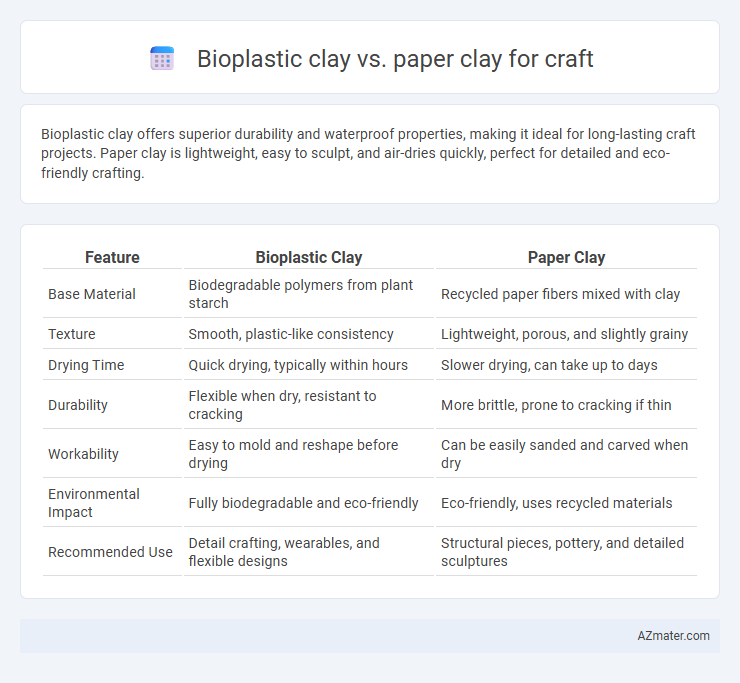Bioplastic clay offers superior durability and waterproof properties, making it ideal for long-lasting craft projects. Paper clay is lightweight, easy to sculpt, and air-dries quickly, perfect for detailed and eco-friendly crafting.
Table of Comparison
| Feature | Bioplastic Clay | Paper Clay |
|---|---|---|
| Base Material | Biodegradable polymers from plant starch | Recycled paper fibers mixed with clay |
| Texture | Smooth, plastic-like consistency | Lightweight, porous, and slightly grainy |
| Drying Time | Quick drying, typically within hours | Slower drying, can take up to days |
| Durability | Flexible when dry, resistant to cracking | More brittle, prone to cracking if thin |
| Workability | Easy to mold and reshape before drying | Can be easily sanded and carved when dry |
| Environmental Impact | Fully biodegradable and eco-friendly | Eco-friendly, uses recycled materials |
| Recommended Use | Detail crafting, wearables, and flexible designs | Structural pieces, pottery, and detailed sculptures |
Introduction to Bioplastic Clay and Paper Clay
Bioplastic clay is a versatile, eco-friendly modeling material made from biodegradable plant-based polymers, offering durability and water resistance ideal for crafting detailed sculptures. Paper clay consists of refined cellulose fibers combined with clay, enhancing flexibility and reducing cracking during drying, making it perfect for delicate and lightweight art projects. Both materials provide unique textural qualities and environmental benefits, catering to different artistic techniques and preferences in the craft community.
Composition and Ingredients: Bioplastic vs Paper Clay
Bioplastic clay primarily consists of cornstarch, water, and natural oils, making it biodegradable and flexible, while paper clay is made from a combination of paper pulp, clay minerals, and water, giving it a lightweight yet strong texture ideal for fine detail work. The bioplastic clay's composition allows it to be non-toxic and reusable, whereas paper clay's fiber content enhances adhesion and reduces cracking during drying. Both materials cater to eco-conscious crafting but differ in handling due to their distinct organic ingredients and drying properties.
Environmental Impact and Sustainability
Bioplastic clay, derived from renewable plant-based materials such as cornstarch, offers significant environmental benefits due to its biodegradability and reduced reliance on petroleum-based plastics. Paper clay combines traditional clay with recycled paper fibers, enhancing its sustainability by utilizing waste materials and reducing the amount of virgin clay needed, which in turn lowers the environmental footprint. Both materials promote eco-friendly crafting practices, but paper clay's incorporation of recycled content and bioplastic clay's compostable properties make them ideal choices for sustainable art projects.
Ease of Use: Workability and Handling
Bioplastic clay offers superior flexibility and smooth texture, making it easier to mold and shape for intricate craft designs. Paper clay's lightweight and porous nature allows for excellent adhesion and drying speed, though it may require more careful handling to prevent cracking. Both materials provide distinct workability benefits, with bioplastic clay favored for detailed manipulation and paper clay preferred for layering and sculptural projects.
Drying Time and Curing Methods
Bioplastic clay typically dries faster than paper clay, often air-drying within 24 to 48 hours depending on thickness, while paper clay may require 48 to 72 hours or longer due to its higher moisture content. Curing methods for bioplastic clay often include baking at low temperatures to harden and strengthen the material, whereas paper clay usually relies on air drying and sometimes kiln firing for complete curing. Understanding the drying times and curing techniques is essential for achieving optimal durability and finish in craft projects using these clays.
Durability and Longevity of Finished Crafts
Bioplastic clay offers superior durability due to its flexible, water-resistant properties, making finished crafts more resilient to cracking and wear over time. Paper clay, while lighter and easier to mold, tends to be more fragile and porous, which can lead to reduced longevity unless sealed properly. Choosing bioplastic clay enhances the lifespan and strength of crafts intended for long-term display or handling.
Finishing Techniques: Painting, Sanding, and Sealing
Bioplastic clay offers a smooth, non-porous surface ideal for detailed painting and achieves an even finish with light sanding, while paper clay's porous texture absorbs paints differently, requiring sealing to prevent blotchy appearances. When sanding, bioplastic clay withstands abrasion without crumbling, allowing for precise refinements, whereas paper clay needs gentle sanding to avoid surface damage due to its fibrous composition. Sealing bioplastic clay enhances durability and gloss, whereas paper clay benefits from sealants that stabilize the porous surface, improving paint adhesion and preventing moisture absorption.
Safety and Non-Toxicity for Crafters
Bioplastic clay offers a non-toxic, eco-friendly alternative to traditional clays, making it safe for crafters of all ages due to its plant-based ingredients and lack of harmful chemicals. Paper clay, composed primarily of refined cellulose fibers mixed with clay, is also considered non-toxic, but it may contain additives that require checking for allergen sensitivities. Both materials promote safe crafting environments, but bioplastic clay's biodegradability and allergen-free properties provide a superior option for health-conscious artisans.
Cost Comparison: Bioplastic Clay vs Paper Clay
Bioplastic clay typically costs more than paper clay due to its synthetic materials and specialized polymer components, making it less budget-friendly for large-scale projects. Paper clay, made primarily from cellulose fibers mixed with traditional clay, offers a more affordable option for artists and crafters seeking lightweight and flexible sculpting materials. The price difference between bioplastic and paper clay can impact final project expenses, especially when factoring in drying time, durability, and finishing requirements.
Best Applications and Project Ideas for Each Clay Type
Bioplastic clay excels in creating detailed, durable sculptures and jewelry due to its smooth texture and ability to harden without baking, making it ideal for eco-friendly projects and model-making. Paper clay, favored for its lightweight and porous nature, is perfect for hand-building pottery, mixed-media art, and decorative figurines that benefit from its easy-to-sand finish and paint adhesion. Each clay type supports unique craft applications: bioplastic clay suits fine, intricate designs requiring longevity, while paper clay enhances larger, textured works with a natural, matte surface.

Infographic: Bioplastic clay vs Paper clay for Craft
 azmater.com
azmater.com